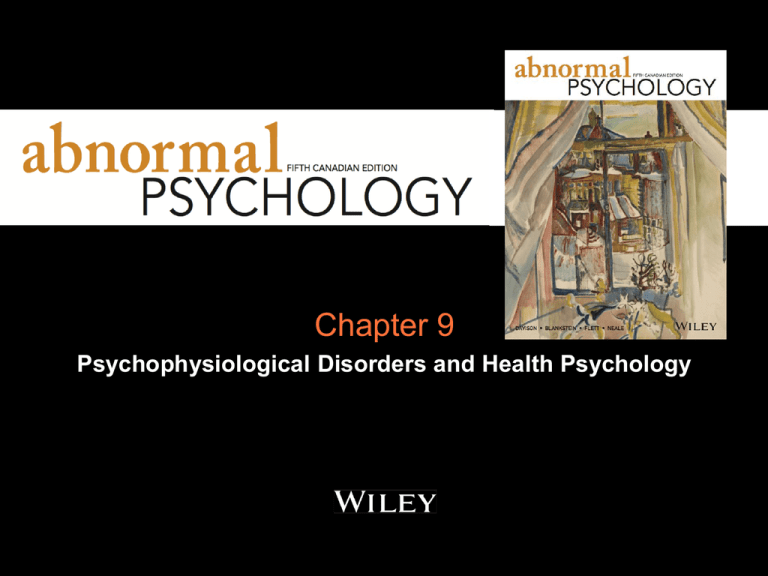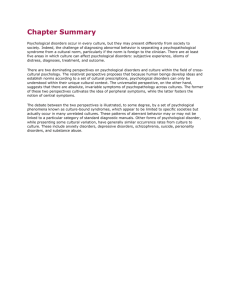
Chapter 9
Psychophysiological Disorders and Health Psychology
Chapter Outline
•
•
•
•
•
Stress and Health
Theories of the Stress-Illness Link
Cardiovascular Disorders
Socio-Economic Status, Ethnicity, and Health
Therapies for Psychophysiological Disorders
Psychophysiological Disorders
•
•
•
•
•
•
•
•
•
•
Psychophysiological Disorders
characterized by genuine physical symptoms
caused by or worsened by emotional factors
Examples: asthma, hypertension, headache, and gastritis
Used to be termed psychosomatic disorders
DSM-IV required diagnostic judgment to indicate
presence of psychological factors affecting medical
condition
DSM-5 considers that psychiatric disorders and medical
disorders are NOT distinct.
eliminated DSM-IV-TR Axis III – General medical
conditions
The field is called Health Psychology and Behavioural
Medicine
Prevention is a major focus
Psychophysiological vs.
Conversion Disorders
Stress
•
•
•
coined by Canadian scientist Hans Selye (“father” of
stress)
refers to environmental conditions that trigger
psychopathology
General Adaptation Syndrome (GAS) outlines the effects
of sustained and unrelenting stress on our bodies,
resulting in illness
Key Terms
•
•
•
Stressor – stress as a stimulus
• Examples found in research: electric shock,
boredom, uncontrollable stimuli, catastrophic life
events, daily hassles, and sleep deprivation
Two main kinds of stressors
• Psychogenic
• Psychological factors
• Example: anticipation of bad things happening
Neurogenic
• Physical stimulus
• Example: Bodily injury
Stress and the Nervous System
1. Autonomic Nervous System (ANS)
Involuntary (automatic) response to
stimuli
ANS is divided into two parts:
•
•
•
•
•
Sympathetic nervous system
Parasympathetic nervous system
Sympathetic nervous system responsible
for dilating pupils,
heart rate, digestion etc.
2. Somatic Nervous System
Voluntary nervous system
•
Nervous System and Health
•
•
•
Sympathetic nervous system is important for responding
to acute danger – ‘fight or flight’ response
however, chronic activation of the sympathetic nervous
system is directly linked to health problems, according to
research
Allostatic load refers to ‘wear and tear’ on the body
when there is exposure to intense and prolonged
demands
Measuring Stress
The Social Readjustment Rating Scale
•
•
•
•
•
Stress is defined by major life events
Scores are referred to as Life Change Units
arbitrarily assigned marriage as middle ranked event
highest stress event – death of a spouse
Research: life events (life changes), illness
Measuring Stress (cont.)
Measuring Stress (cont.)
•
•
Life events scale criticized because it does not
account well for day to day stressors termed:
daily hassles
Cognitive appraisals (Lazarus, 1966) are also
important in understanding stress
determines whether situations are viewed
as ‘stress’ or ‘challenge’ (like a glass halfempty or half-full)
•
Burnout
•
•
•
•
usually related to job stress
linked to physical problems as well as psychological
problems such as depression
characterized by:
emotional exhaustion
tendency to be insensitive
lack sense of personal accomplishment
Vital exhaustion – extreme form of burnout
•
•
•
Coping and Stress
•
•
•
Problem-focused coping
Taking direct action to solve the problem or seeking
information that will be relevant to the solution; most
adaptive when the individual can do something about
the situation
Emotion-focused coping
Efforts to reduce the negative emotional reactions to
stress; most adaptive when the situation is
uncontrollable
Goodness of fit hypothesis
The adaptivity of a particular coping response depends
on the match between the coping response and what
is called for ideally by the problem situation
•
•
•
Ways of Coping
Stress and Illness
Health Status of Students
•
•
•
•
•
•
•
•
•
•
Research shows college/ university students do not rate
themselves as having better health even compared with older
populations
Predictors of less positive health status in students:
Poorer child-parent relationship;
Low interest and achievement in school;
Lower self-esteem and
Women reported more health problems than male students
Top health problems in students:
Allergy (47.9%), back pain (41.6%), sinus infection (30.7%),
depression (17.0%), strep throat (13.8%)
Top five factors interfering with academic performance:
Stress (33.9%), cold/flu/sore throat (28.2%), sleep difficulties
(25.6%), concern for troubled friend/family member (18.8%),
Internet use/computer games (16.9%)
Moderators of Stress-Illness Link
Social Support
• Structural social support
• basic network of social relationships
• Functional social support
• Quality of relationships
• Emotional support
•
Provides a sense of being cared for by warm and sensitive
others
• Instrumental support
• Provides more tangible forms of assistance
• Social support linked to health
•
•
People with few friends or relatives tend to have mortality
rate
levels of functional support linked to atherosclerosis and
ability of women to adjust to chronic rheumatoid arthritis
•
Psychophysiological Disorders
Theories of Stress-Illness Link
Three important questions related to causes of
psychophysiological disorders:
1. Why does stress produce illness in only some people
who are exposed to it?
2. Why does stress sometimes cause an illness and not a
psychological disorder?
3. When stress produces a psychophysiological disorder,
what determines which one of the many disorders will be
produced?
Psychophysiological Disorders (cont.)
Biological Theories
•
Somatic-Weakness Theory
Weakness in a specific body organ
Example: congenitally weak respiratory system might
predispose the individual to asthma
Specific-Reaction Theory
Individual response to stress is idiosyncratic
Prolonged Exposure to Stress Hormones
Activation of SNS and HPA axis (see next - Figure
9.6)
Stress and the Immune System
Stress impact the ANS, hormone levels, brain activity
(see next - Figure 9.7)
•
•
•
•
•
•
•
•
HPA Axis
Stress and the Immune System
Psychophysiological Disorders (cont.)
Psychological Theories
•
•
•
Psychoanalytic Theory
Specific unconscious emotional states are
associated with specific psychophysiological
disorders
Anger-in theory has been researched as
possible contributor to essential hypertension
Cardiovascular Disorders
•
•
•
•
•
•
•
•
•
•
•
•
•
Two diseases involving heart and blood-circulation
system appear to be adversely affected by stress
Essential Hypertension
Coronary Heart Disease (CHD)
Essential Hypertension
Hypertension without identified biological cause
Sometimes called: Primary hypertension
Known as the silent killer (may go undetected for years)
Measurement of blood pressure (BP)
Systolic pressure
Amount of arterial pressure when ventricles contract
and heart is pumping
Diastolic pressure
Degree of arterial pressure when ventricles relax and
heart is resting
Normal blood pressure in a young adult is 120/ 80
Cardiovascular Disorders (Cont.)
Risk Factors for High BP
Cardiovascular Disorders (Cont.)
Predisposing Factors
•
•
•
•
Genetics – still little success in identifying
specific genes
Biology – heightened cardiovascular reactivity
in response to exposure to stressors
Psychology - acute stress such as anger
episodes and physical exertion can trigger
myocardial infarction
Chronic stress (marital conflict, financial
worries) activates immune system and
contributes to inflammation, which, in turn,
produces coronary heart disease
Cardiovascular Disorders (Cont.)
Coronary Heart Disease (CHD)
•
•
•
•
•
•
•
CHD takes 2 principal forms:
Angina pectoris
Periodic chest pains
Cause of pain—insufficient supply of oxygen to
heart (ischemia) due to coronary
atherosclerosis
Myocardial infarction (‘heart attack’)
Much more serious disorder
Similar to angina pectoris BUT usually results
in permanent damage to the heart
Cardiovascular Disorders (Cont.) Risk
Factors of CHD
• size of the left
• Age
ventricle in heart
• Sex (males are at • Obesity
greater risk)
•
Long-standing
• Cigarette smoking pattern of physical
inactivity
• Elevated blood
pressure
• Excessive use of
alcohol
• Elevated serum
cholesterol
• Diabetes
Cardiovascular Disorders (Cont.)
Psychological Diatheses
•
•
Psychological Diatheses (predispositions)
Type A behaviour pattern
Intense and competitive drive for achievement
and advancement;
Exaggerated sense of the urgency;
Aggressiveness and hostility toward others
•
•
•
•
Type D (distressed) personality
Negative affectivity + social inhibition, including the
inhibition of anger, anxiety and depression
•
Cardiovascular Disorders (Cont.)
SES, Ethnicity, and Health
•
Low socio-economic status (SES) is associated
with rates of mortality from all causes
•
•
•
SES more likely to engage in behaviours that risk
for disease
Smoking, eating a high-fat diet, and drinking excessive
amounts of alcohol
Social gradient of health
•
•
Inequalities in SES are considered to reflect
inequalities in health status
SES also confers health disadvantages because
linked with sense of perceived controllability
Therapies for Psychophysiological
Disorders
• Treating hypertension through CHD risk factors
•
•
•
anxiety, depression, or anger is best way to
psychophysiological disorders
Also smoking, obesity, alcohol consumption, salt
intake, exercise, etc.
Drugs can be used to cholesterol levels
•
Lovastatin (Mevacor) lowers low-density lipid cholesterol
• Biofeedback
•
Effectiveness of biofeedback has only modest
empirical support
• Cardiac Rehabilitation Efforts
•
Support and counseling aimed at stress
Stress Management
•
•
•
Arousal Reduction
training in muscle relaxation, sometimes assisted
by biofeedback
Cognitive Restructuring
See approaches by Ellis (1962) and Beck (1976)
Focus is on altering belief systems and improving
the clarity of logical interpretations of experience
Mindfulness
trait mindfulness associated with pain
catastrophization
manualized 10-week group approach for
developing mindful awareness of perceptible
experiences in a way that is non-evaluative and
emotionally non-reactive
Behavioural Skills Training
Learning and practicing required skills, including
assertion skills
•
•
•
•
•
•
•
Pain Management
•
•
How common are problems with pain?
•
3.6 million Canadians perceived activities restricted by
physical problems
•
Most common disabilities are linked with pain
Gate-control theory of pain
•
•
Nerve impulses connoting pain reach spinal column and
spinal column controls pain sensations sent to brain
Gate—area of the spinal column known as the dorsal horns
•
•
Traditional medical treatments seldom help with chronic pain
Maladaptive strategy for coping with pain
• Acute Pain
• Sense of personal control important in dealing with acute pain
• Chronic Pain
•
Catastrophization
Copyright
•
Copyright © 2014 John Wiley & Sons Canada, Ltd. All rights
reserved. Reproduction or translation of this work beyond that
permitted by Access Copyright (The Canadian Copyright
Licensing Agency) is unlawful. Requests for further information
should be addressed to the Permissions Department, John
Wiley & Sons Canada, Ltd. The purchaser may make back-up
copies for his or her own use only and not for distribution or
resale. The author and the publisher assume no responsibility
for errors, omissions, or damages caused by the use of these
programs or from the use of the information contained herein.








